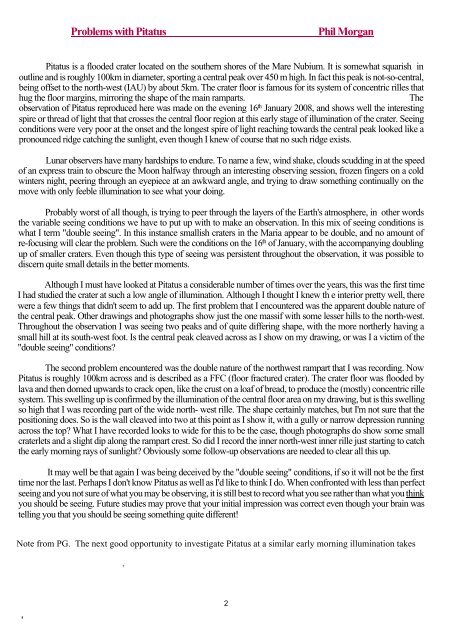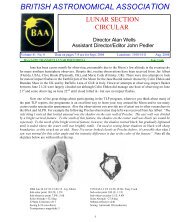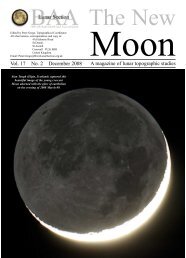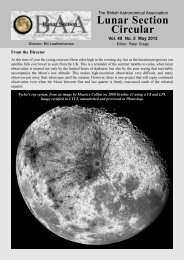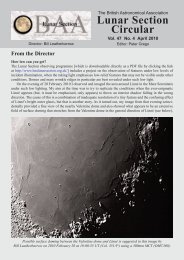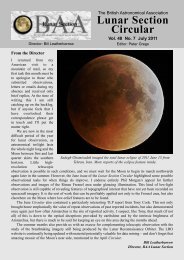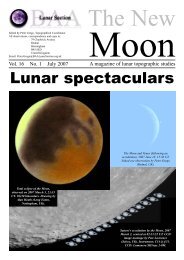Vol 45, No 3, March 2008 - BAA Lunar Section
Vol 45, No 3, March 2008 - BAA Lunar Section
Vol 45, No 3, March 2008 - BAA Lunar Section
- No tags were found...
You also want an ePaper? Increase the reach of your titles
YUMPU automatically turns print PDFs into web optimized ePapers that Google loves.
Problems with PitatusPhil MorganPitatus is a flooded crater located on the southern shores of the Mare Nubium. It is somewhat squarish inoutline and is roughly 100km in diameter, sporting a central peak over <strong>45</strong>0 m high. In fact this peak is not-so-central,being offset to the north-west (IAU) by about 5km. The crater floor is famous for its system of concentric rilles thathug the floor margins, mirroring the shape of the main ramparts.Theobservation of Pitatus reproduced here was made on the evening 16 th January <strong>2008</strong>, and shows well the interestingspire or thread of light that that crosses the central floor region at this early stage of illumination of the crater. Seeingconditions were very poor at the onset and the longest spire of light reaching towards the central peak looked like apronounced ridge catching the sunlight, even though I knew of course that no such ridge exists.<strong>Lunar</strong> observers have many hardships to endure. To name a few, wind shake, clouds scudding in at the speedof an express train to obscure the Moon halfway through an interesting observing session, frozen fingers on a coldwinters night, peering through an eyepiece at an awkward angle, and trying to draw something continually on themove with only feeble illumination to see what your doing.Probably worst of all though, is trying to peer through the layers of the Earth's atmosphere, in other wordsthe variable seeing conditions we have to put up with to make an observation. In this mix of seeing conditions iswhat I term "double seeing". In this instance smallish craters in the Maria appear to be double, and no amount ofre-focusing will clear the problem. Such were the conditions on the 16 th of January, with the accompanying doublingup of smaller craters. Even though this type of seeing was persistent throughout the observation, it was possible todiscern quite small details in the better moments.Although I must have looked at Pitatus a considerable number of times over the years, this was the first timeI had studied the crater at such a low angle of illumination. Although I thought I knew th e interior pretty well, therewere a few things that didn't seem to add up. The first problem that I encountered was the apparent double nature ofthe central peak. Other drawings and photographs show just the one massif with some lesser hills to the north-west.Throughout the observation I was seeing two peaks and of quite differing shape, with the more northerly having asmall hill at its south-west foot. Is the central peak cleaved across as I show on my drawing, or was I a victim of the"double seeing" conditions?The second problem encountered was the double nature of the northwest rampart that I was recording. <strong>No</strong>wPitatus is roughly 100km across and is described as a FFC (floor fractured crater). The crater floor was flooded bylava and then domed upwards to crack open, like the crust on a loaf of bread, to produce the (mostly) concentric rillesystem. This swelling up is confirmed by the illumination of the central floor area on my drawing, but is this swellingso high that I was recording part of the wide north- west rille. The shape certainly matches, but I'm not sure that thepositioning does. So is the wall cleaved into two at this point as I show it, with a gully or narrow depression runningacross the top? What I have recorded looks to wide for this to be the case, though photographs do show some smallcraterlets and a slight dip along the rampart crest. So did I record the inner north-west inner rille just starting to catchthe early morning rays of sunlight? Obviously some follow-up observations are needed to clear all this up.It may well be that again I was being deceived by the "double seeing" conditions, if so it will not be the firsttime nor the last. Perhaps I don't know Pitatus as well as I'd like to think I do. When confronted with less than perfectseeing and you not sure of what you may be observing, it is still best to record what you see rather than what you thinkyou should be seeing. Future studies may prove that your initial impression was correct even though your brain wastelling you that you should be seeing something quite different!<strong>No</strong>te from PG. The next good opportunity to investigate Pitatus at a similar early morning illumination takes2


